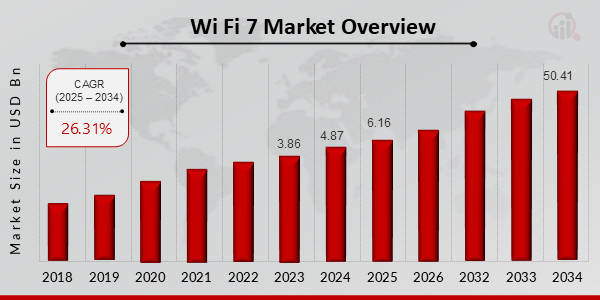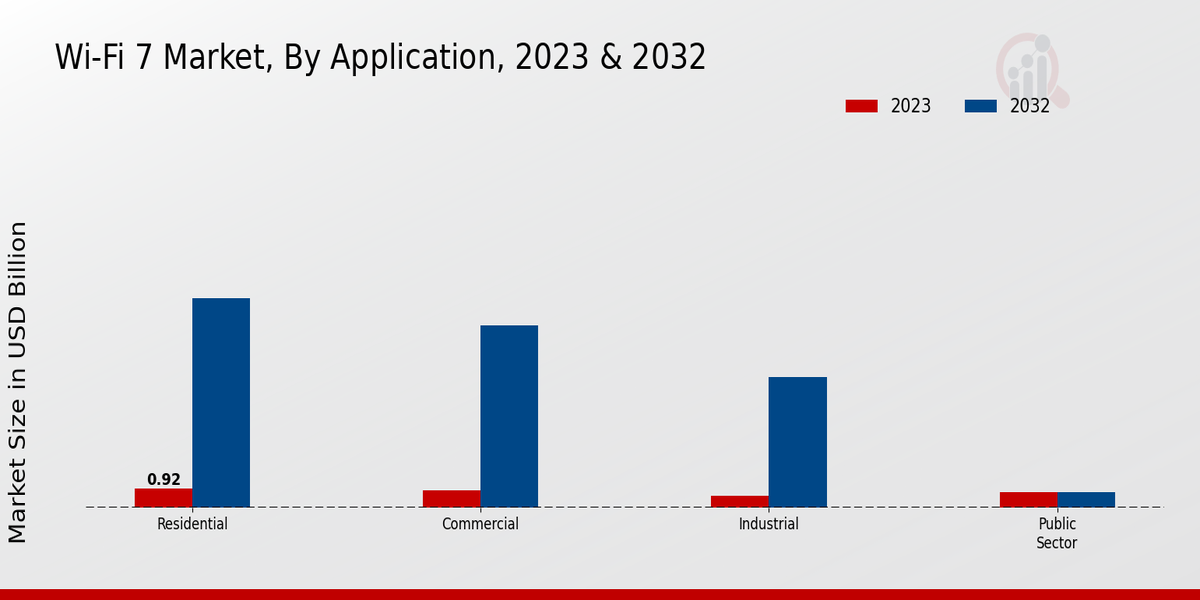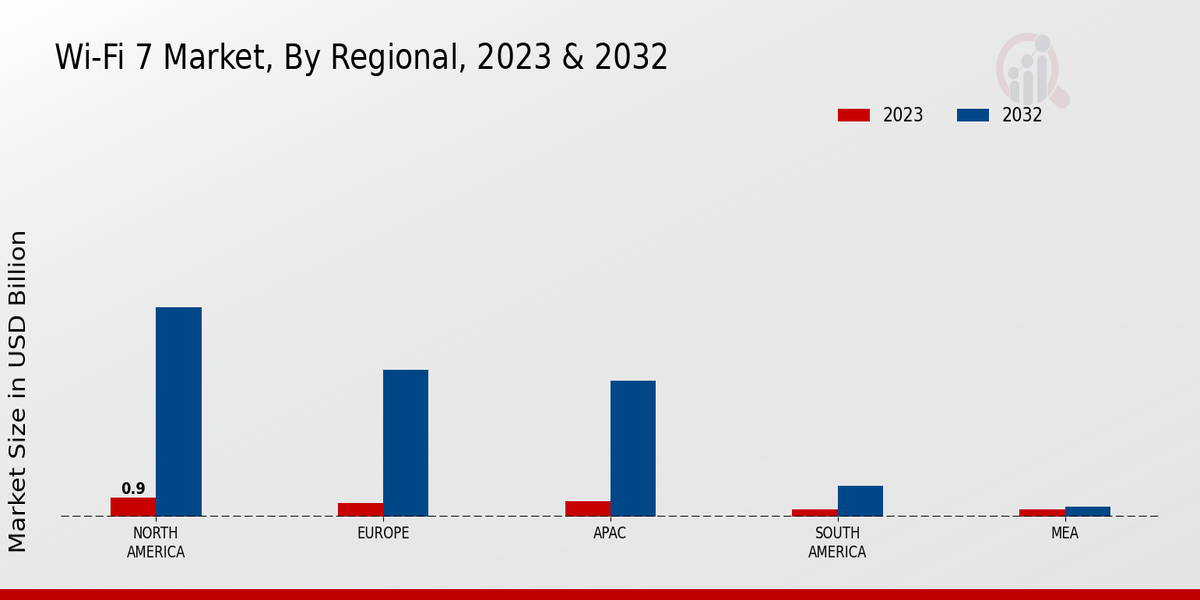Wi-Fi 7 Market Overview
Wi Fi 7 Market is projected to grow from USD 6.16 Billion in 2025 to USD 50.41 Billion by 2034, exhibiting a compound annual growth rate (CAGR) of 26.31% during the forecast period (2025 - 2034).
Additionally, the market size for Wi Fi 7 Market was valued at USD 4.87 billion in 2024.
Key Wi-Fi 7 Market Trends Highlighted
The Wi-Fi 7 Market is driven by the increasing demand for higher data rates and faster internet speeds among consumers and businesses. As more devices become connected and the reliance on high-bandwidth applications grows, the need for robust wireless solutions has intensified. Wi-Fi 7 aims to address these requirements by providing improved performance and efficiency, making it an attractive solution for various sectors, including education, healthcare, and entertainment. This growing demand for connectivity solutions is a primary factor fueling the market's growth. Opportunities in the Wi-Fi 7 Market include the expansion of Internet of Things (IoT) applications and the rising trend of smart homes and smart cities.
With more devices connecting to the internet, the need for efficient and reliable wireless networks is at an all-time high. Enterprises are looking to upgrade their infrastructure to accommodate the influx of connected devices, thereby creating a substantial market opportunity for Wi-Fi 7 technology. Additionally, advancements in technology and increased investments in research and development can help unlock further possibilities in this evolving market. Recent trends indicate a shift towards wireless technology that can handle multiple connections simultaneously, enhancing user experience and overall network performance.
The importance of seamless connectivity has prompted manufacturers to ramp up their development of Wi-Fi 7 equipment, ensuring compatibility with next-gen devices. Furthermore, as remote work and online communication continue to be pivotal for businesses and consumers alike, the importance of high-speed internet access is more significant than ever. This ongoing trend emphasizes the necessity for efficient wireless solutions that Wi-Fi 7 aims to deliver, highlighting its relevance in contemporary digital landscapes.
Figure 1: Wi-Fi 7 Market size 2025-2034

Source: Primary Research, Secondary Research, MRFR Database and Analyst Review
Wi-Fi 7 Market Drivers
Increased Demand for High-Speed Internet Connectivity
The Wi-Fi 7 Market is experiencing an unprecedented surge in demand for high-speed internet connectivity, driven largely by the rapid digital transformation across various sectors. As more businesses and consumers rely on internet-enabled devices for their daily activities, the need for faster and more reliable wireless connections becomes paramount. Wi-Fi 7 addresses this need by significantly enhancing bandwidth and network efficiency. The technology supports multiple channels for simultaneous device connections, thereby decreasing latency and increasing overall performance. This is especially important for environments with a high density of devices, such as smart homes, corporate offices, and public spaces.
Moreover, as the number of connected devices continues to rise, with the Internet of Things (IoT) expanding rapidly, the Wi-Fi 7 Market provides a vital solution to ensure that all equipment can operate effectively without compromising speed or stability. Companies in various sectors are investing heavily in upgrading their infrastructures to leverage these advancements in wireless technology, which also drives competition among vendors to adopt Wi-Fi 7 capabilities. Therefore, the continuous hike in demand for robust, secure, and fast internet services signifies a strong growth trajectory for the Wi-Fi 7 Market.
Growing Adoption of Smart Home and IoT Devices
The increasing adoption of smart home devices and various Internet of Things (IoT) applications is significantly driving growth in the Wi-Fi 7 Market. With consumers increasingly embracing automation technologies that facilitate smart lighting, security systems, and home entertainment, there is a pressing need for advanced Wi-Fi networks that can efficiently support these interconnected devices.
Wi-Fi 7 enables enhanced data throughput and reduced congestion, making it ideal for environments with multiple IoT devices that rely on stable and fast connectivity. As more households integrate smart technology into their daily lives, the demand for Wi-Fi 7 technology becomes essential for ensuring optimal performance.
Emergence of 5G Infrastructure
The rollout of 5G technology across the globe is fostering synergy with the Wi-Fi 7 Market, serving as a significant market driver. 5G services promise high-speed, low-latency mobile connectivity, which, when combined with the capabilities of Wi-Fi 7, presents a robust networking ecosystem. This combination allows users to seamlessly switch between mobile and Wi-Fi networks depending on their needs without compromising connectivity. As businesses and consumers look for integrated solutions that enhance the connectivity experience, the ability of Wi-Fi 7 to support such advanced functionalities is likely to drive its adoption.
Wi-Fi 7 Market Segment Insights
Wi-Fi 7 Market Application Insights
The Wi-Fi 7 Market is experiencing robust growth, particularly within the Applications segment which includes critical areas such as Residential, Commercial, Industrial, and Public Sector. Within this overarching market, the Residential segment held a notable share, valued at 0.921 USD billion in 2023 and projected to grow to 9.73 USD billion by 2032. This dominance is largely attributed to the increasing deployment of internet-enabled devices in homes, reinforcing the necessity for advanced wireless technology to satisfy user demand for seamless streaming, gaming, and smart home applications.
The Commercial segment also played a critical role, valued at 0.8 USD billion in 2023 and anticipated to rise to 8.45 USD billion by 2032. The importance of this sector is evident as businesses increasingly require reliable and high-performance networks to support multiple connected devices, facilitate remote working, and enhance productivity through improved communication technologies. The Industrial segment, valued at 0.581 USD billion in 2023, is expected to experience growth up to 6.09 USD billion by 2032. The need for robust networking solutions in factories, warehouses, and supply chains for IoT applications underlines the industrial sector's significance, as Wi-Fi 7 technology offers improved reliability, lower latency, and higher capacity for machine-to-machine communications.
Lastly, the Public Sector was valued at 0.747 USD billion in 2023 and is projected to slightly lower at 0.73 USD billion by 2032. This sector typically requires reliable and secure networking solutions for its various services, though it currently does not dominate compared to other segments, which signifies potential areas for growth and innovation. The collective insights from these segments not only illustrate the diverse applications of the Wi-Fi 7 Market but also point to significant opportunities for market expansion driven by increasing connectivity demands across various sectors.
The Wi-Fi 7 Market data illustrates a robust momentum towards enhanced connectivity, posing growth opportunities driven by evolving consumer preferences and technological advancements that promise to dominate the scenario in the near future. The Wi-Fi 7 Market statistics reveal critical insights into how these application segments cater to emerging demands, making them integral to the industry's trajectory.

Source: Primary Research, Secondary Research, MRFR Database and Analyst Review
Wi-Fi 7 Market Technology Insights
Over the next several years, market growth will be significantly contributed by advancements in technological solutions across various domains. The router segment holds a substantial share, catering to both residential and commercial users and responding to the demand for enhanced internet speeds and connectivity. Access points are emerging as crucial elements in expanding network coverage, particularly in densely populated areas.
Mesh networks are gaining traction due to their ability to provide seamless connectivity across larger spaces, making them favorable for smart homes and IoT applications. Additionally, extenders are important for amplifying signals in hard-to-reach areas, ensuring uninterrupted connectivity. The Wi-Fi 7 Market segmentation reflects a comprehensive mix of these technologies, highlighting their collective potential to enhance user experiences. Statistical trends in this industry point toward a transformational shift, with organizations increasingly prioritizing seamless and high-performance networking solutions as key growth drivers.
Wi-Fi 7 Market Connectivity Type Insights
The Wi-Fi 7 Market is set to experience significant growth driven by various connectivity types, which are crucial in shaping the overall market dynamics. Among the connectivity types, the dual-band and Tri-Band configurations are particularly influential due to their ability to support higher data rates and improved network performance, catering to the increasing need for seamless online experiences in both home and business environments.
Single Band remains relevant but shows lower growth potential, mainly used in simpler applications. The ongoing trend toward smart home devices and the growing demand for high-definition streaming services are key growth drivers, pushing consumers to prioritize robust connectivity solutions. However, challenges such as network congestion and the need for compatible devices could impact market expansion. Nevertheless, opportunities arise from the continuous innovation in wireless technologies, allowing for enhanced user experiences. Overall, the Wi-Fi 7 Market data highlights a trend toward increasing usage of more sophisticated configurations as industries and consumers seek improved connectivity and bandwidth solutions.
Wi-Fi 7 Market End Use Insights
The increasing digitalization across various sectors drives demand within the End Use segment, which incorporates diverse applications such as Smart Homes, Office Spaces, Educational Institutions, and Healthcare Facilities. Smart Homes leverage Wi-Fi 7 technology for enhanced connectivity among smart devices, contributing to efficient home management. Office Spaces significantly employ this technology to optimize communication and productivity through high-speed internet access, reflecting a shift towards remote work and collaboration.
Educational Institutions benefit from robust Wi-Fi networks, ensuring seamless delivery of digital learning tools and resources, crucial for modern education. In the Healthcare Facilities sector, Wi-Fi 7 supports critical applications, ranging from telemedicine to electronic health records, thereby improving patient care and operational efficiency. Collectively, these areas represent a substantial portion of the Wi-Fi 7 Market segmentation, addressing the evolving need for high-speed, reliable connectivity. The market not only shows promising statistics but also embodies trends that respond to evolving consumer demands and technological advancements, fostering a landscape ripe with opportunities and challenges alike.
Wi-Fi 7 Market Regional Insights
The Wi-Fi 7 Market revenue is witnessing substantial growth, driven by escalating demand for high-speed connectivity and technological advancements. In 2023, North America held a majority share, valued at 0.904 USD billion, and is expected to dominate further, reaching 9.804 USD billion by 2032. This region benefits greatly from a mature telecommunications infrastructure and the rising adoption of smart devices Europe followed, with a valuation of 0.64 USD billion in 2023, forecasted to reach 6.863 USD billion in 2032, reflecting significant investment in digital transformation initiatives. The APAC region, valued at 0.753 USD billion in 2023, is anticipated to grow to 6.373 USD billion, driven by rapid urbanization and increasing internet penetration in countries like India and China.
In South America, the market was valued at 0.377 USD billion in 2023, with continued growth expected to reach 1.471 USD billion by 2032, influenced by improving broadband access. Meanwhile, the MEA accounted for 0.377 USD billion in 2023, with an outlook of 0.49 USD billion by 2032, driven mainly by ongoing digital initiatives in several countries. Overall, these regions reveal the dynamic landscape of the Wi-Fi 7 Market segmentation, shaped by unique drivers and opportunities.

Source: Primary Research, Secondary Research, MRFR Database and Analyst Review
Wi-Fi 7 Market Key Players and Competitive Insights
The Wi-Fi 7 Market is poised for significant growth, driven by advancements in wireless communication technology and the increasing demand for high-speed internet connectivity. As the world continues to move towards more interconnected environments, the competition within this market is becoming more intense. Companies are racing to develop innovative solutions that leverage the capabilities of Wi-Fi 7, which promise faster data transfer rates, lower latency, and enhanced network efficiency. This heightened competition encourages continuous innovation, and the introduction of cutting-edge products designed to meet evolving consumer needs.
The market dynamics underscore the importance of strategic partnerships, research and development investments, and agile marketing strategies as companies position themselves for success in this rapidly advancing technological landscape. Qualcomm has established a formidable presence in the Wi-Fi 7 Market, capitalizing on its extensive expertise in semiconductor technology and wireless communication. The company's strength lies in its ability to deliver high-performance chipsets that facilitate seamless connectivity and superior user experiences.
Qualcomm's products are designed to support the capabilities of Wi-Fi 7, including features such as multi-channel operation and increased bandwidth. With a strong commitment to innovation and a robust portfolio of intellectual property, Qualcomm is well-positioned to cater to the diverse needs of OEMs and service providers in the Wi-Fi 7 ecosystem. Its strategic focus on developing cutting-edge technology ensures that Qualcomm remains a key player in driving the future of wireless connectivity, leveraging its strong brand reputation and extensive distribution networks to penetrate various markets effectively.
DLink is actively participating in the Wi-Fi 7 Market, seeking to expand its product offerings to include next-generation networking solutions. The company's strength lies in its commitment to delivering reliable and user-friendly devices that cater to both consumer and business segments. DLink aims to integrate Wi-Fi 7 technology into its existing line of routers, access points, and mesh networking solutions to offer enhanced performance and connectivity options. This focus on user-centric design and robust performance allows DLink to position itself favorably in the competitive landscape. By continually engaging in research and development and leveraging its experience in the networking hardware space, DLink seeks to meet the rising demand for faster, more efficient, and reliable wireless networking solutions amidst the growing adoption of Wi-Fi 7 technology.
Key Companies in the Wi-Fi 7 market Include
-
Qualcomm
-
DLink
-
Netgear
-
Linksys
-
Arista Networks
-
Huawei
-
NETGEAR
-
Cisco
-
ZTE
-
Broadcom
-
ASUS
-
TP-Link
-
Intel
-
MikroTik
-
Marvell Technology
Wi-Fi 7 Market Developments
Recent developments in the Wi-Fi 7 Market have shown a significant upswing, with companies such as Qualcomm, Cisco, and Broadcom intensifying their efforts to advance wireless technology. Qualcomm has reported robust demand for Wi-Fi 7 chips, expected to provide a higher capacity and efficiency, which has enhanced its market position. DLink and TP-Link are ramping up product launches with new Wi-Fi 7 routers that promise faster speeds and improved connectivity. Arista Networks has also expanded its offerings to include Wi-Fi 7 solutions, catering to enterprises looking for cutting-edge technology.
On the mergers and acquisitions front, there have been reports of Huawei seeking partnerships with regional telecom operators to bolster its Wi-Fi 7 offerings and enhance its competitiveness. Moreover, NETGEAR and Linksys are actively pursuing collaborations to integrate Wi-Fi 7 capabilities into their product lines, reflecting a strategic move amidst growing market valuation. The increasing adoption of smart home devices further drives the need for higher bandwidth, leading to a positive growth trajectory in the market. This competitive environment is fostering innovation and collaboration among key players to meet the rising demand for advanced wireless solutions.
Wi-Fi 7 Market Segmentation Insights
-
Wi-Fi 7 Market Application Outlook
-
Residential
-
Commercial
-
Industrial
-
Public Sector
-
Wi-Fi 7 Market Technology Outlook
-
Router
-
Access Point
-
Mesh Network
-
Extenders
-
Wi-Fi 7 Market Connectivity Type Outlook
-
Single Band
-
Dual Band
-
Tri-Band
-
Wi-Fi 7 Market End Use Outlook
-
Smart Homes
-
Office Spaces
-
Educational Institutions
-
Healthcare Facilities
-
Wi-Fi 7 Market Regional Outlook
-
North America
-
Europe
-
South America
-
Asia Pacific
-
Middle East and Africa
|
Report Attribute/Metric
|
Details
|
|
Market Size 2024
|
4.87 (USD Billion)
|
|
Market Size 2025
|
6.16 (USD Billion)
|
|
Market Size 2034
|
50.41 (USD Billion)
|
|
Compound Annual Growth Rate (CAGR)
|
26.31% (2025 - 2034)
|
|
Report Coverage
|
Revenue Forecast, Competitive Landscape, Growth Factors, and Trends
|
|
Base Year
|
2024
|
|
Market Forecast Period
|
2025 - 2034
|
|
Historical Data
|
2019 - 2023
|
|
Market Forecast Units
|
USD Billion
|
| Key Companies Profiled |
Qualcomm, DLink, Netgear, Linksys, Arista Networks, Huawei, NETGEAR, Cisco, ZTE, Broadcom, ASUS, TP-Link, Intel, MikroTik, Marvell Technology |
| Segments Covered |
Application, Technology, Connectivity Type, End Use, Regional |
| Key Market Opportunities |
High demand for faster connectivity, Expansion in smart home devices, Enhanced performance for gaming, Growth in IoT applications, and Increased adoption in urban areas |
| Key Market Dynamics |
Increased data consumption, Growing smart device adoption, Enhanced network capacity, Demand for low-latency applications, and Expanding IoT ecosystem |
| Countries Covered |
North America, Europe, APAC, South America, MEA |
Frequently Asked Questions (FAQ) :
The expected market size of the Wi-Fi 7 Market in 2034 is 50.41 USD billion.
The projected CAGR for the Wi-Fi 7 Market from 2025 to 2034 is 26.31%.
North America is expected to dominate the Wi-Fi 7 Market with a value of 9.804 USD billion by 2034
The market value of the Commercial application segment in 2034 is projected to be 8.45 USD billion.
Qualcomm is one of the major players in the Wi-Fi 7 Market.
The Residential segment of the Wi-Fi 7 Market is expected to be worth 9.73 USD billion in 2034
The expected market size for the APAC region in 2034 is 6.373 USD billion.
The Industrial application segment is expected to reach a value of 6.09 USD billion in 2034
The expected market value for the Public Sector application in 2034 is projected to be 0.73 USD billion.
The value of the Wi-Fi 7 Market in the MEA region in 2034 is expected to be 0.49 USD billion.





























